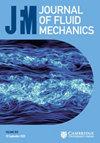流体流经螺旋管道时的惯性颗粒聚焦:动力学、倾倒现象和颗粒分离
IF 3.9
2区 工程技术
Q1 MECHANICS
引用次数: 0
摘要
在流体流经封闭的弯曲管道时,悬浮的有限尺寸小颗粒会在二维管道横截面上聚焦成点或周期性轨道。这种颗粒聚焦现象是由于轴向流动产生的惯性升力和横截面涡流产生的阻力之间的平衡造成的。惯性颗粒聚焦现象已在各种工业和医疗应用中得到开发,利用纯粹的流体动力学效应按颗粒大小进行被动分离。在一个具有均匀矩形截面的圆形管道中,一个固定大小的颗粒会有多种颗粒吸引器,如稳定节点/螺旋或极限循环,这取决于管道的曲率半径。在不同曲率半径处会出现分岔,如叉形分岔、鞍形节点分岔和鞍形节点无限周期分岔(SNIPER),从而导致这些粒子吸引子的位置、数量和性质发生变化。通过使用准稳近似方法,我们将 Harding 等人(《流体力学》,第 875 卷,2019 年,第 1-43 页)针对圆形管道中粒子动力学建立的理论模型扩展到曲率缓慢变化的螺旋管道几何结构中,并对其中的粒子动力学进行了数值探索。粒子吸引子相对于曲率半径的分岔可以在螺旋管道内穿越,并产生丰富的非线性粒子动力学和各种类型的倾覆现象,如分岔诱导倾覆(B-倾覆)、速率诱导倾覆(R-倾覆)以及两者的结合,我们将对此进行详细探讨。我们讨论了这些不稳定动力学行为对颗粒分离的影响,并提出了以非平衡方式按大小分离颗粒的新机制。本文章由计算机程序翻译,如有差异,请以英文原文为准。
Inertial particle focusing in fluid flow through spiral ducts: dynamics, tipping phenomena and particle separation
Small finite-size particles suspended in fluid flow through an enclosed curved duct can focus to points or periodic orbits in the two-dimensional duct cross-section. This particle focusing is due to a balance between inertial lift forces arising from axial flow and drag forces arising from cross-sectional vortices. The inertial particle focusing phenomenon has been exploited in various industrial and medical applications to passively separate particles by size using purely hydrodynamic effects. A fixed size particle in a circular duct with a uniform rectangular cross-section can have a variety of particle attractors, such as stable nodes/spirals or limit cycles, depending on the radius of curvature of the duct. Bifurcations occur at different radii of curvature, such as pitchfork, saddle-node and saddle-node infinite period (SNIPER), which result in variations in the location, number and nature of these particle attractors. By using a quasi-steady approximation, we extend the theoretical model of Harding et al. (J. Fluid Mech. , vol. 875, 2019, pp. 1–43) developed for the particle dynamics in circular ducts to spiral duct geometries with slowly varying curvature, and numerically explore the particle dynamics within. Bifurcations of particle attractors with respect to radius of curvature can be traversed within spiral ducts and give rise to a rich nonlinear particle dynamics and various types of tipping phenomena, such as bifurcation-induced tipping (B-tipping), rate-induced tipping (R-tipping) and a combination of both, which we explore in detail. We discuss implications of these unsteady dynamical behaviours for particle separation and propose novel mechanisms to separate particles by size in a non-equilibrium manner.
求助全文
通过发布文献求助,成功后即可免费获取论文全文。
去求助
来源期刊
CiteScore
6.50
自引率
27.00%
发文量
945
审稿时长
5.1 months
期刊介绍:
Journal of Fluid Mechanics is the leading international journal in the field and is essential reading for all those concerned with developments in fluid mechanics. It publishes authoritative articles covering theoretical, computational and experimental investigations of all aspects of the mechanics of fluids. Each issue contains papers on both the fundamental aspects of fluid mechanics, and their applications to other fields such as aeronautics, astrophysics, biology, chemical and mechanical engineering, hydraulics, meteorology, oceanography, geology, acoustics and combustion.

 求助内容:
求助内容: 应助结果提醒方式:
应助结果提醒方式:


